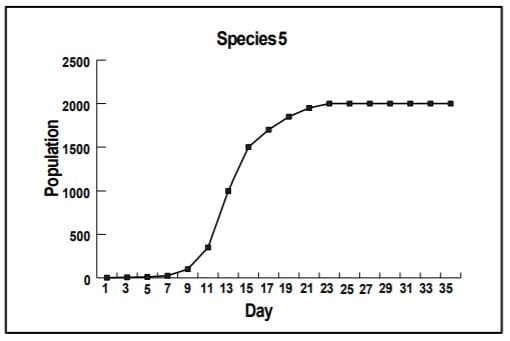Describe the definitions of predator and prey
predator- hunter
prey- hunted
What is the letter of the alphabet associated with BOTH types of growth? (1 letter for each logistic and exponential)
J - Exponential
S - Logistic
What type of growth will experience a carrying capacity?
Describe the differences between population density and population distribution
density- how many
distribution- how they are placed
What are ecosystem services?
benefits provided to us from the earth (nutrient cycling, water purifying)
When the population of prey increases, what usually happens to the population of predators shortly after?
they increase as well
Which type of growth requires unlimited resources and is not typically sustained for long periods of time?
Exponential
What is the carrying capacity? 
around 7,600
What is an organism called if the organism is found outside of its geographic range?
invasive species
Deforestation can disrupt the carbon cycle. Explain how cutting down large areas of forest contributes to climate change
It reduces the number of trees that absorb CO₂ through photosynthesis, increasing greenhouse gases in the atmosphere
Draw a graph that will represent a predator/prey relationship
Graph where both lines "follow" each other with fluctuations
Draw a graph that will represent logistic growth
At what point did the population reach carrying capacity? 
When the graph began to fluctuate around a given point (squiggly line)
What are biotic and abiotic factors that control the growth of populations?
limiting factors
Describe how the loss of biodiversity can make ecosystems less resilient to environmental changes or natural disasters.
fewer species means fewer available roles and genetic diversity, so ecosystems can’t adapt or recover as easily from disturbances
Why can removing a top predator, like a wolf or shark, negatively affect an ecosystem’s balance?
because prey populations may grow uncontrollably, reducing vegetation or prey species and disrupting the entire food web
What type of growth:
In 2020, a pair of rabbits are introduced to Green Island, which has abundant grass, mild weather, and no natural predators. Each pair of rabbits produces a new litter every month, and each litter has enough offspring to form another reproducing pair after one month.
Exponential
Around what day did this population reach carrying capacity? 
about day 21
What is the difference between density-dependent limiting factors and density-independent limiting factors?
Density-dependent: affect populations of a certain size (resource availability, competition)
Density-independent: affect all populations in similar ways (weather, natural disasters)
Explain how bioaccumulation and biomagnification can cause toxins like mercury or DDT to harm top predators.
Toxins build up in organisms over time (bioaccumulation) and increase in concentration up the food chain (biomagnification), making top predators most affected
Explain why predator and prey populations often cycle over time instead of remaining constant.
because changes in one population affect the availability of food or survival in the other, causing a repeating rise and fall pattern
What type of growth do human experience? Why?
Exponential due to advances in civilization
What happened between 2 011 and 2013 in the graph?
011 and 2013 in the graph?
overshoot and crash
What are the 4 factors that contribute to population growth? Describe each
birth- number born
death- number dead
immigration- number moved in
emigration- number exited
Climate change, habitat destruction, and pollution are all major threats to ecosystems. Propose one realistic human solution that addresses all three issues at once, and explain the scientific reasoning for how it helps reduce each impact
answers may vary
restoring and protecting wetlands
Wetlands and forests absorb CO₂, helping to mitigate climate change. They provide habitats for many species, reducing habitat loss. They filter pollutants and improve water quality, decreasing pollution